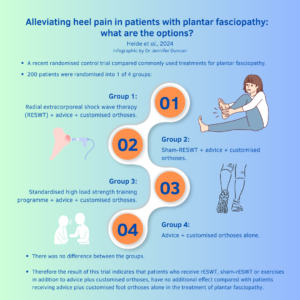Keywords: radial extracorporeal shock wave therapy, high-load strength training, orthoses
In this blog we will explain our recently published randomised controlled trial that compared treatments for plantar fasciopathy (1).
Why is this study important?
Plantar fasciopathy is a common foot condition and affects function and health-related quality of life. The choice of practice is debated and there is no evidence of a single treatment being superior to another. There is a lack of unity about the optimal non-surgical treatment strategy for plantar fasciopathy, but information and advice regarding activity supplied with orthoses, radial extracorporeal shock wave therapy (rESWT) and more specific training approaches are frequently used (2,3). High-load strength training or heavy slow resistance training have shown promising effects in the treatment of Achilles and Patellar tendinopathy (4, 5), while few trials have evaluated the effect in the plantar fasciopathy population. Radial extracorporeal shock therapy is a popular choice and has been reported to be more effective than sham-rESWT. But due to methodological limitations of previous trials, more high-quality studies are warranted to determine if the treatment is ideal, particularly for the long-term resolution of symptoms (6). A recent best practice guide proposed a stepped approach starting with education, taping and stretching, and the addition of rESWT and custom orthoses if recovery failed. However, the optimal insole type and therapeutic effect remain uncertain (7).
This study is important because it compares commonly used treatments for patients with plantar fasciopathy. No previous studies have compared advice plus customised foot orthoses to advice plus customised foot orthoses with additional rESWT, sham-rESWT or a high-load strength training programme.
How did the study go about this?
In this trial 200 patients were randomised to 1 of 4 groups:
- rESWT in addition to advice plus customised foot orthoses,
- sham-rESWT in addition to advice plus customised foot orthoses,
- Standardised high-load strength training programme in addition to advice plus customised foot orthoses or
- Advice plus customised foot orthoses alone
The patients randomised to groups 1 and 2 (rESWT/sham-rESWT) received 3 treatments over 3 weeks, while patients in the training group (group 3) performed two high-load strength training exercises 3 times a week for 12 weeks, including 8 supervised sessions with a physiotherapist. Patients randomised to advice plus customised foot orthoses alone (group 4), did not receive any additional treatment. Outcomes were collected at 3, 6 and 12 months and included measurements for pain, foot function and health-related quality of life. Heel pain during activity last week, measured on the Numeric Rating Scale (NRS), was the main outcome measured at 6 months.
What did the study find?
We found no additional benefit of rESWT, sham-rESWT or a standardised exercise programme over advice plus customised foot orthoses in alleviating heel pain in patients with plantar fasciopathy. Patients in all treatment groups demonstrated significant improvement in heel pain and function compared to the start of the study.
What are the key take-home points?
The result of this trial indicates that patients who receive rESWT, sham-rESWT or exercises in addition to advice plus customised orthoses have no additional effect compared with patients receiving advice plus customised foot orthoses alone in the treatment of plantar fasciopathy.

Blog authors: Marte Heide and Marianne Mørk
References:
- Heide M, Røe C, Mørk M, et alIs radial extracorporeal shock wave therapy (rESWT), sham-rESWT or a standardised exercise programme in combination with advice plus customised foot orthoses more effective than advice plus customised foot orthoses alone in the treatment of plantar fasciopathy? A double-blind, randomised, sham-controlled trialBritish Journal of Sports Medicine 2024;58:910-918.
- Babatunde OO, Legha A, Littlewood C, Chesterton LS, Thomas MJ, Menz HB, et al. Comparative effectiveness of treatment options for plantar heel pain: a systematic review with network meta-analysis. Br J Sports Med. 2019;53(3):182-94.
- Lourenço BM, Campos MGM, Maia L, Castro B, Trede RG, Oliveira VC. Efficacy of pharmacological and non-pharmacological therapies on pain intensity and disability for plantar fasciitis: a systematic review and meta-analysis. Br J Sports Med. 2023;57(23):1516-21.
- van der Vlist AC, Winters M, Weir A, et al. Which treatment is most effective for patients with achilles tendinopathy? A living systematic review with network meta-analysis of 29 randomised controlled trials. Br J Sports Med 2021;55:249–56. 10.1136/bjsports-2019-101872
- Breda SJ, Oei EHG, Zwerver J, et al. Effectiveness of progressive tendon-loading exercise therapy in patients with patellar tendinopathy: a randomised clinical trial. Br J Sports Med 2021;55:501–9. 10.1136/bjsports-2020-103403
- Sun J, Gao F, Wang Y, Sun W, Jiang B, Li Z. Extracorporeal shock wave therapy is effective in treating chronic plantar fasciitis: A meta-analysis of RCTs. Medicine (Baltimore). 2017;96(15):e6621.
- Morrissey D, Cotchett M, Said J’Bari A, et al. Management of plantar heel pain: a best practice guide informed by a systematic review, expert clinical reasoning and patient values. Br J Sports Med 2021;55:1106–18. 10.1136/bjsports-2019-101970